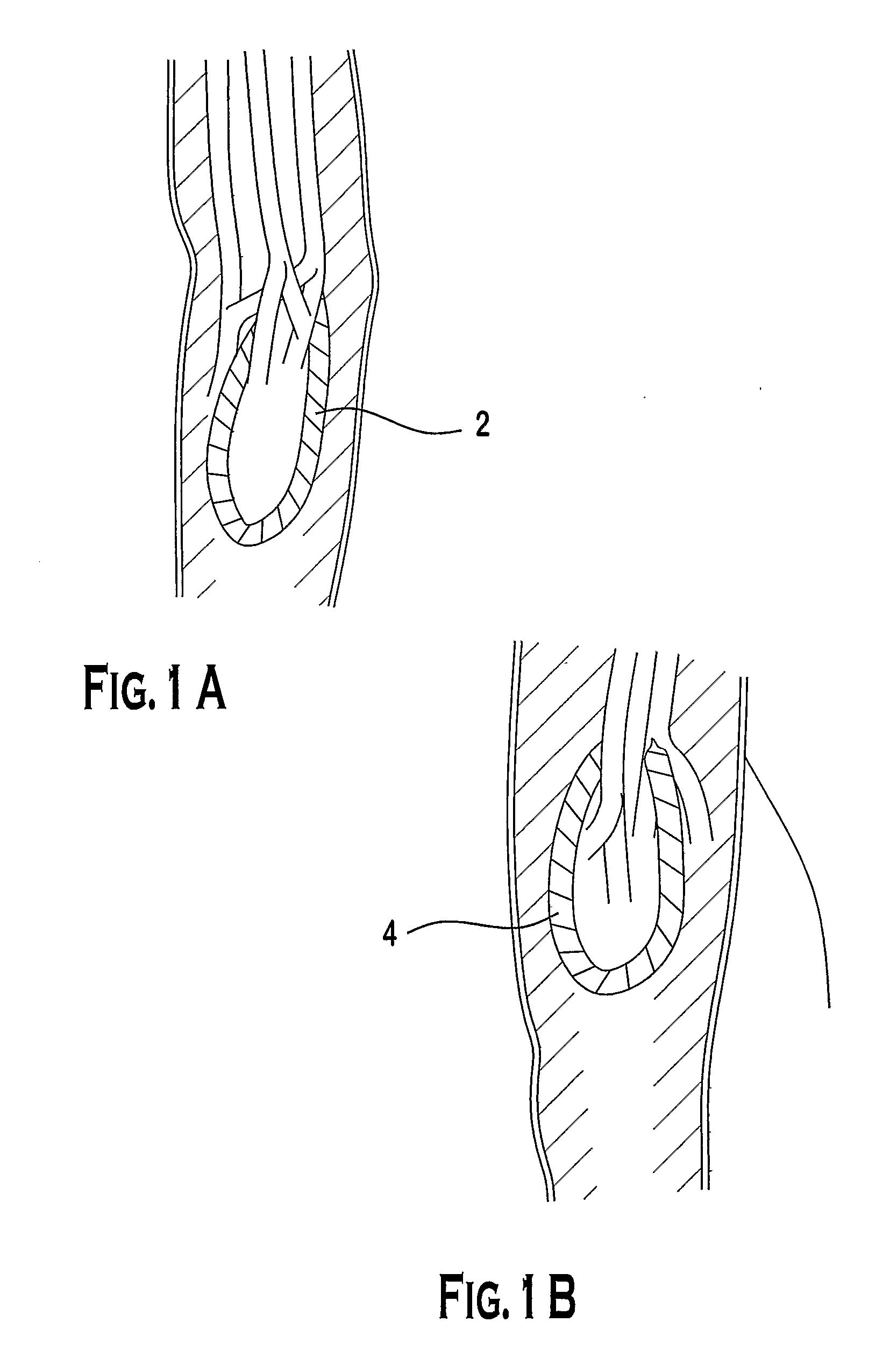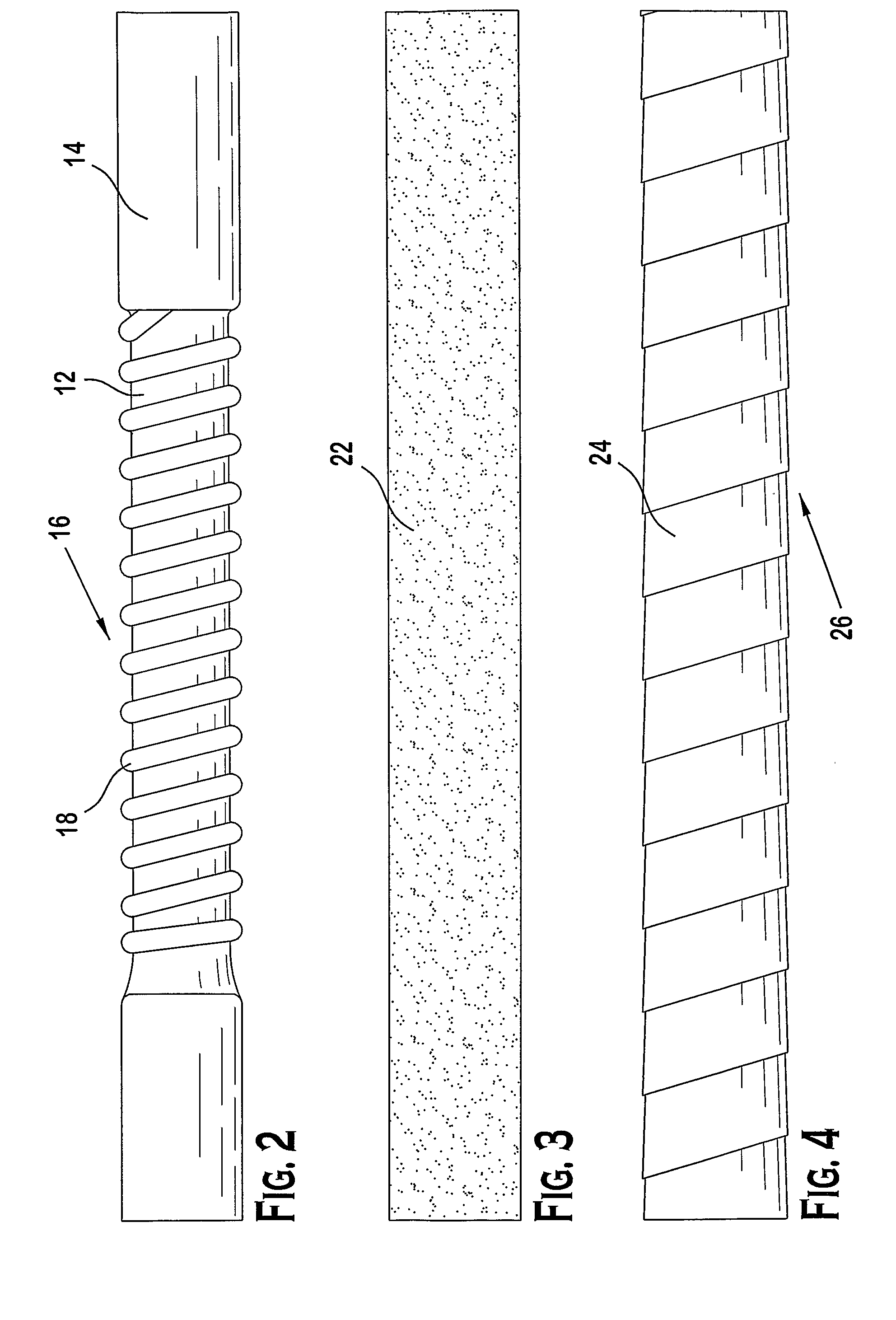Self-Sealing Ptfe Graft with Kink Resistance
a kink resistance, self-sealing technology, applied in the direction of prosthesis, coating, blood vessels, etc., can solve the problems of inability to safely withdraw blood for hemodialysis, inability to use a large artery for repeated punctures, and insufficient blood flow from the venous system to meet the required flow rate. , to achieve the effect of high porosity gra
- Summary
- Abstract
- Description
- Claims
- Application Information
AI Technical Summary
Benefits of technology
Problems solved by technology
Method used
Image
Examples
experiment a
[0052] High porosity (HP) grafts were provided, along with regular wall (RW) grafts and thin-wall (TW) grafts, each having a length of 6 cm and a diameter of 6 mm. A 25% solution of BioSpan® segmented polyurethane (commercially available from Polymer Technology Group, Inc.) in dimethyl acetamide (DMAC) was diluted to 9-12% solution using DMAC. The diluted solution containing polyurethane (PU) was spray-coated on selected grafts (i.e., RWPU, TWPU and HPPU (see table 3)). The solvent was removed by heating the coated grafts at an oven air temperature of 70° C. for about 10 minutes. Additional coats were applied to achieve the final coating thickness. The coated grafts were then dried in a substantial vacuum at a temperature of 70° C. for about 10-16 hours. Control RW, TW and HP grafts without coating were also provided.
TABLE 3CoatingThicknessPolymer CodeGraft Description(microns)Control RWRegular wall (RW) graft,N / A700 microns thick, 10-20 microns IND.Control TWThin wall (TW) graft,...
experiment b
[0064] A 6 mm ePTFE graft was provided. Approximately 12 grams Carbothane® PC-3585A was dissolved in approximately 88 grams dimethyl acetamide (DMAC) to prepare an approximately 12% solution. The polymer solution was then spray-coated using a Binks Model 2001 spray gun with a nozzle orifice diameter less than about 1 mm on the outside surface of the graft after the graft was first longitudinally compressed. The solvent was removed by heating the coated graft at an oven air temperature of about 70° C. for about 10 minutes. Additional coats were applied to achieve a coating having a thickness of about 50-300 microns. The coated graft was dried in a substantial vacuum at about 70° C. for about 1-16 hours. The exterior sealant surface of the coated graft was then sprayed with DMAC (for polyurethane sealant) to soften the polymer coat. It is noted here that in the case that a silicone based sealant is used for the outer sealant layer, a material such as P-Xylene can be used to soften the...
experiment c
[0069] A polymer coated ePTFE graft was placed on a mandrel and was fixed between two chucks located on an automated rotary fixture. A graphic was designed using software that interfaces with a CO2 laser and scans the laser beam to etch the graphic on a given surface. Laser parameters were set and upon actuation of the start sequence, the laser cut grooves into the sealant layer of the coated ePTFE graft. The laser beam was adjusted so that only grooves in the sealant layer were created such that the ePTFE surface was not affected by the laser. Several types of grooves were cut and evaluated for kink resistance. The results of this experiment appeared to be that the best kink resistance resulted when the distance between grooves was minimized (i.e., in the range of about 1 mm to about 5 mm) and / or the angle of the grooves through the surface of the sealant layer was in the range of approximately 80-90° relative to the axis of the graft (i.e., approximately perpendicular with respect...
PUM
| Property | Measurement | Unit |
|---|---|---|
| distance | aaaaa | aaaaa |
| thickness | aaaaa | aaaaa |
| length | aaaaa | aaaaa |
Abstract
Description
Claims
Application Information
 Login to View More
Login to View More - R&D
- Intellectual Property
- Life Sciences
- Materials
- Tech Scout
- Unparalleled Data Quality
- Higher Quality Content
- 60% Fewer Hallucinations
Browse by: Latest US Patents, China's latest patents, Technical Efficacy Thesaurus, Application Domain, Technology Topic, Popular Technical Reports.
© 2025 PatSnap. All rights reserved.Legal|Privacy policy|Modern Slavery Act Transparency Statement|Sitemap|About US| Contact US: help@patsnap.com



